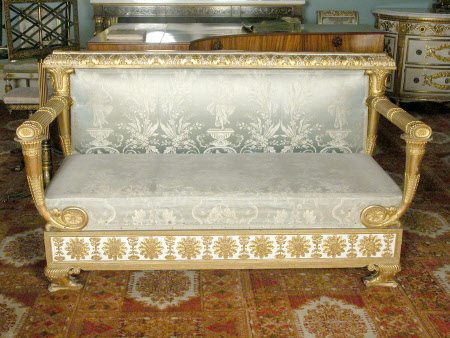Sofa
probably Giocondo Albertolli (1742 - 1839)
Category
Furniture
Date
circa 1814
Materials
Walnut, pine, gilding, paint and silk lampas
Measurements
93.5 x 171 x 73 cm
Place of origin
Genoa
Order this imageCollection
Attingham Park, Shropshire
NT 608161
Summary
A carved, gilded and painted walnut open armchair, probably Genoa, circa 1814, related to designs by Giocondo Albertolli (1742-1839), covered with blue and white silk lampas, Lyon, France, after a design by Philippe de Lasalle (1723-1804), made before 1842 (when listed as in storage at Attingham). The sofa closely related to NT 608173, an open armchair, and contemporary with, the daybed of Maria Teresa of Austria-Este, Queen of Sardinia (1773-1832) and an open armchair ensuite with the daybed. The toprail pedimented, painted and carved with wheat, tassels and flowers. It, and the tubular arms on the form of bound fasces, are raised on cornucopiae. The seat rail white-painted and applied with carved gilt flowerheads or sunbursts alternating with floral stems, raised on unusual scroll feet. The silk cover is catalogued separately (NT 609545.8.1).
Full description
This sofa was almost certainly acquired by William Noel-Hill, 3rd Baron Berwick (1773-1842), while ambassador to Italy. He represented George III at the exiled royal court of Sardinia at Cagliari, then in Turin, and finally Naples and returned to England with a large collection of Italian furniture. Four pieces from this collection form a group - this sofa and an armchair, and a daybed and its accompanying armchair - which are believed to be contemporary, and to have been made in Genoa around 1814, after (or influenced by) the designs by Giocondo Albertolli (1742-1839). The other white-painted and gilded Italian furniture at Attingham is now thought to date from the 1820s and to have been designed by Carlo Randoni (1755-1831). For many years the daybed’s cipher has been misread as CM rather than MT (the French and Italian 'T' resembling an English 'C') and was therefore thought to be connected to Napoleon’s sister, Princess Caroline Murat (1782-1839), rather than the more likely previous owner, Queen Maria Teresa of Sardinia (1773-1832). Berwick was ambassador to the court of Maria Teresa and her husband King Vittorio Emanuele I of Sardinia (1759-1824) from 1807 to 1824. This sofa's scrolled feet are comparable with those of the daybed and both pieces employ cornucopiae as decorative uprights or supports. Its arms - formed from bound fasces (rods) - which, it in turn, shares with the daybed and matching armchair a distinctive Vitruvian scroll frieze incorporating buds of acanthus, taken from plates in Albertolli's Ornamenti Diversi (1782). The 3rd Baron Berwick may have acquired this sofa around 1824, when Maria Teresa moved from Turin to Genoa, but it is possible that she took this sofa (and the armchair, the daybed and its matching armchair) with her to furnish her new home. If this is the case, then he may have acquired this furniture after her death in 1832 and before his return to England – via Genoa – in 1833. The silk with which this chair, as well as the daybed, is covered, was originally green and white but has faded. It is almost certainly some of the silk which was noted as being in store at Attingham in 1842. The daybed is known to have been re-covered with it sometime between 1861 and 1898.
Provenance
3rd Lord Berwick collection: William Noel-Hill, 3rd Baron Berwick (1773-1842). Acquired by the 3rd Lord Berwick, who had been in Italy as British envoy and ambassador to the Kingdom of Naples and the Two Sicilies. By descent bequeathed to the National Trust with the estate, house and contents of Attingham by Thomas Henry Noel-Hill, 8th Baron Berwick (1877-1947) on 15th May 1953.
Makers and roles
probably Giocondo Albertolli (1742 - 1839), designer
References
Rowell & Burchard 2020: Christopher Rowell & Wolf Burchard, 'Italian Furniture at Attingham Park', Furniture History LVI (2020), 107-176, 118-9, Figure 15 Tipping, 1921: Henry Avray Tipping, ‘Attingham Shropshire II. The seat of Lord Berwick’ Country Life, 12 February, 1921, pp.186-193, p. 190, figures 7-8. Drury, 1984: Martin Drury. “Italian furniture in National Trust houses.” Furniture History, vol. XX, 1984., pp. 38-44; p. 42
